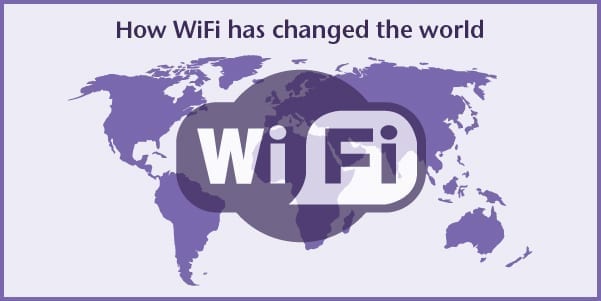Life before the Internet
Despite the fact that many of us experienced life before WiFi, it has become virtually impossible to imagine our personal and working lives without it. Being connected to the internet means we can achieve things far quicker and more efficiently than in the past: handwritten letters sent via post have been overtaken by emails and texts; lengthy lines at the high street bank are now in-app queues for chat support; trips to the library have been replaced by instant book downloads onto a Kindle or iPad. With access to millions of apps, online stores, and an insurmountable wealth of information online, it’s almost more difficult to imagine the things we cannot do as opposed to the things we can do.
The Internet (Pre-WiFi)
Since the early days of dial-up, the internet has revolutionized the way we live. Unlike our pre-internet days, being connected allowed us to access the world at the touch of a button.
One of the more notable changes of the post-internet era was the way people chose to communicate with one another. Those with access to an internet connection were able to instantly chat or email their family, friends, and pen pals across the globe. International friendships were far easier, online dating was made possible, and people were able to create their own personalised websites to reflect their interests.
The internet also began to function as a historic database, storing mind-boggling amounts of publicly accessible data. People no longer had to go to the library and scroll through newspapers to find out information. Future generations will also opt go online to gain a perspective on who or what was trending even decades prior to their search.
A Change in the Way We Use the Internet
Once the world got a taste of the internet, there was no slowing down. As more and more people came online, the demand for easier access and an improved service increased. According to a study by Pew Research Centre, our love for the internet even surpassed television, as the public would rather abandon their TV over their internet access.
The next logical step in improving the internet experience was to make it more accessible in homes, workplaces, and the public – as you may have guessed, this is when WiFi came into play. Almost instantaneously, WiFi made it easier to access the internet, as laptops and other mobile devices could be taken to the nearest WiFi ‘hotspot’ or booster.
With unprecedented access to the internet, the amount of people getting online increased dramatically: in 2000, when WiFi was less common, 52% of Americans went online per day compared to 88% in 2016. Undoubtedly, the universal integration of WiFi has played a significant role in democratizing the internet, meaning more of us have been able to get online (even if we don’t have a personal connection at home).
Making A Better Society
As WiFi technology continues to develop, the potential to improve ourselves and our society steadily increases. According to the BBC, Police can now use their mobile devices to instantly track mugshots and criminal records and view sensor networks capable of picking up the location of perpetrators. More recently, law enforcement have also begun using aerial drones, microcomputers, and biometric technology to tackle crime and identify perpetrators.
Social media is also playing a vital role in crime reduction and the improvement of emergency services: police are using social media to engage and inform the public on various issues, and also use it to request information. With 86% of Americans on social accounts as well, social media has begun to function as an extra emergency outlet – if an emergency situation arises, we can take the likes of Facebook and Twitter (with presumably hundreds of friends / followers / connections) to request help or alert others.
Healthcare establishments have also seen many major advances using WiFi, largely through the use of location services and wayfinding tools to get patients and equipment to the right location. According to the WiFi Alliance, there is already a variety of applications that use and rely on Wi-Fi in the healthcare industry, including infusion pumps, oxygen monitoring devices, and smart beds, alongside mission-critical information applications such as access to electronic medical records (EMRs) and real-time access to X-rays and MRI scans. They also stated that medical telepresence delivered via Wi-Fi helps scale provision of high-quality healthcare to remote and underserved areas.
With solutions like Purple, hospitals and clinics can also use their WiFi to gain visitor information such as a phone numbers and email addresses, allowing them to prompt visitors for feedback on services and send out information around waiting times. With real-time location services, healthcare establishments can also monitor the position of staff and the use of resources around a hospital building in order to improve efficiency.
Connected Smart Cities
In addition to individual industries, whole cities are now become connected. The benefits of creating a WiFi solution for an entire geographic location is an attractive proposition for both city managers and citizens. Smart Cities that incorporate digital technologies (like Purple) to generate huge amounts of data. This information can be used intelligently by City officials to improve various industries and services within the city such as retail, public transport, facilities, airports, advertising, and more. For citizens, smart cities can also provide citizens with seamless access to the online world no matter where they go.
Going Forward
There’s no doubt about it – WiFi has changed the world. In multiple industries, we are harnessing the power of telecommunications and maximizing the personal and professional benefits of WiFi. The possibilities are truly endless, and we can’t wait to see what the future holds for WiFi technology.
